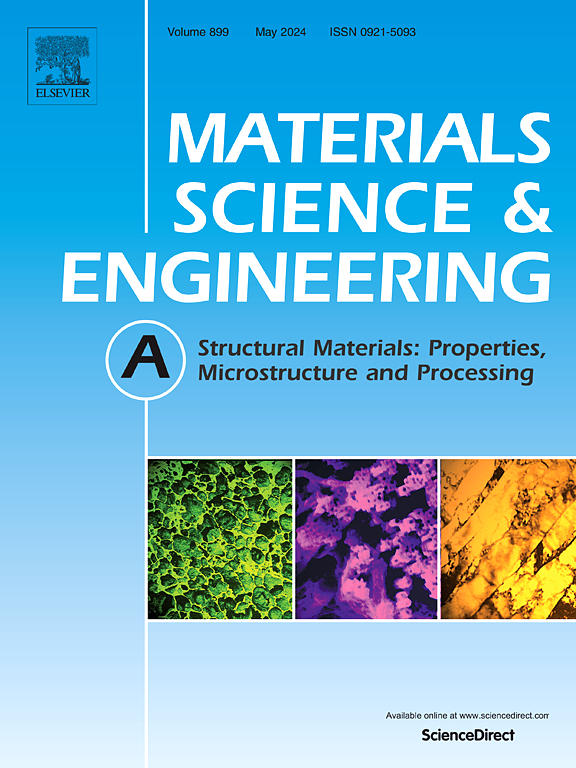Microstructure and mechanical performance study of CrMnFeCoNi high-entropy alloys after cryogenic treatment
IF 6.1
2区 材料科学
Q1 MATERIALS SCIENCE, MULTIDISCIPLINARY
引用次数: 0
Abstract
In recent years, significant progress has been made in the development of high-entropy alloys (HEAs) that possess both high strength and high ductility. The application of the metastable engineering strategy to enhance the strength and ductility of materials has also gradually been employed, and cryogenic treatment is one of the important techniques in this regard. Through cryogenic liquid nitrogen treatment, this study significantly enhanced the strength and ductility of (CrMnFeCoNi)45Fe55 and (CrMnFeCoNi)40Fe60 HEAs prepared by laser melting deposition (LMD). Compared to the initial samples, the fracture strength of (CrMnFeCoNi)45Fe55 increased from 480 MPa (at room temperature) to 980 MPa (after cryogenic treatment), and the fracture elongation alloy increased from 60 % (at room temperature) to 62 % (after cryogenic treatment). The fracture strength of (CrMnFeCoNi)40Fe60 alloy increased from 550 MPa (at room temperature) to 1150 MPa (after cryogenic treatment), and the fracture elongation decreased from 55 % (at room temperature) to 45 % (after cryogenic treatment). The reduction in stacking fault energy (SFE) through cryogenic liquid nitrogen treatment enables the formation of stacking faults in the alloy system. These stacking faults act as nucleation sites for phase transformations, encouraging the shift of the matrix from a face-centered cubic (FCC) phase to a body-centered cubic (BCC) phase or other phases. This triggers phase transformation-induced plasticity effects (TRIP). The occurrence of phase transformation was confirmed using in-situ cryo-TEM. Simultaneously, the coexistence of two phases mechanism achieves an advantageous balance between strength and ductility. Our study offers novel insights and methodologies for acquiring high-entropy alloys with exceptional comprehensive mechanical properties.
低温处理后crmnnfeconi高熵合金的组织与力学性能研究
近年来,具有高强度和高塑性的高熵合金的研究取得了重大进展。应用亚稳工程策略来提高材料的强度和延展性也逐渐被采用,低温处理是这方面的重要技术之一。本研究通过低温液氮处理,显著提高了激光熔融沉积(LMD)制备的(CrMnFeCoNi)45Fe55和(CrMnFeCoNi)40Fe60 HEAs的强度和延展性。与初始试样相比,(CrMnFeCoNi)45Fe55的断裂强度从480 MPa(室温)提高到980 MPa(深冷处理后),断裂伸长率从60%(室温)提高到62%(深冷处理后)。(CrMnFeCoNi)40Fe60合金的断裂强度从550 MPa(室温)提高到1150 MPa(深冷处理后),断裂伸长率从55%(室温)下降到45%(深冷处理后)。低温液氮处理降低了层错能(SFE),使合金体系中形成层错。这些层错作为相变的成核位点,促使基体从面心立方(FCC)相转变为体心立方(BCC)相或其他相。这就触发了相变诱导塑性效应(TRIP)。利用原位冷冻透射电镜证实了相变的发生。同时,两相共存机制实现了强度与延性的良好平衡。我们的研究为获得具有优异综合力学性能的高熵合金提供了新的见解和方法。
本文章由计算机程序翻译,如有差异,请以英文原文为准。
求助全文
约1分钟内获得全文
求助全文
来源期刊

Materials Science and Engineering: A
工程技术-材料科学:综合
CiteScore
11.50
自引率
15.60%
发文量
1811
审稿时长
31 days
期刊介绍:
Materials Science and Engineering A provides an international medium for the publication of theoretical and experimental studies related to the load-bearing capacity of materials as influenced by their basic properties, processing history, microstructure and operating environment. Appropriate submissions to Materials Science and Engineering A should include scientific and/or engineering factors which affect the microstructure - strength relationships of materials and report the changes to mechanical behavior.
 求助内容:
求助内容: 应助结果提醒方式:
应助结果提醒方式:


